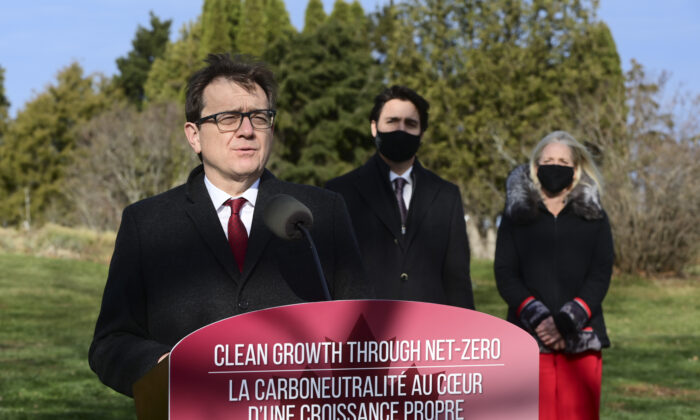
News Analysis
The feds’ latest weapon in their war against carbon emissions is the clean fuel standard (CFS). However, considerable concern is being raised about its implementation, cost, and synchronization with other climate change policies, which if not handled well might deal a heavy blow to the Canadian economy.
The CFS’s track record for emissions reduction has been shown to be dubious. However, its biggest benefit might end up being its incentivizing clean energy innovation, with California as a possible guide.
Some are calling the CFS a second carbon tax, though it is not transparent to consumers like the actual carbon tax. Others point to the differences between the CFS and the carbon tax and view them as complementary policies to achieve a similar objective.
With the CFS, the feds’ goal is to reduce carbon emissions during the entire life cycle from production to consumption. With the carbon tax, their aim is to compel the user to consume less fuel by making it more expensive.
“They do different things,” said Jackie Forrest, executive director, ARC Energy Research Institute, on ARC Energy’s Dec. 8 Ideas Podcast.
The Canada West Foundation (CWF), in December report “A Citizen’s Guide to the Clean Fuel Standard,” likens the CFS to low-fat cheese on pizza to imply a healthier, low-carb diet.
“The carbon tax makes the pizza more expensive so we will buy less of it. The CFS turns it into a low-fat pizza, so that even if we eat the same amount, we have consumed fewer calories,” it said.
The feds published proposed regulations for the CFS on Dec. 18 for a 75-day comment period, shortly after the announced hike in the carbon tax.
“There’s a lot to digest … a lot of education that needs to be done … what this all means,” said Peter Tertzakian, deputy director of the ARC Energy Research Institute, on the podcast. “It’s not just an oil and gas thing; this is going to permeate across the economy.”
Former Liberal MP Dan McTeague, president of Canadians for Affordable Energy, tweeted that the total carbon taxes on gasoline, including the 13 percent HST, would be 56 cents per litre.
“This second carbon tax will be especially cruel for Canadians who heat their homes with oil,” McTeague wrote in a Dec. 18 blog post, adding that Prime Minister Justin Trudeau is trying to achieve “unrealistic and unachievable Paris Agreement commitments.”
A Bold Step Into the Unknown
The CWF’s report warns that the CFS could “accidentally put Canada out of business.” Canada will be the first jurisdiction to extend this type of policy beyond transportation and into fuels for industrial uses and for commercial or residential heating.
Saskatchewan’s Energy and Resources Minister Bronwyn Eyre previously told News Optimist, in September, that the CFS will have a “huge economic crippling impact” if it goes through. She estimated that it will cost Canadians about $15 billion to $20 billion a year in higher gas prices both for home heating and at the pump.
In addition, the CWF notes that there is little indication the feds are coordinating with the provinces to achieve some harmonization of regulations.
“EITE [energy-intensive, trade-exposed] industry commentators have stated that the compound result is multiple layers of cost and regulation on the same set of emissions, which they don’t see as fair,” according to the CWF report.
The Canadian Association of Petroleum Producers said in a statement that it is “analyzing [the] announcement in detail to fully understand its implications for the oil and natural gas industry,” while adding that it will continue to work with the government on maintaining its industry’s environmental leadership, providing good jobs, and driving economic recovery.
It also noted the “positive decision by government to limit the application of the Clean Fuel Standard to liquid fuels in response to concerns raised by Canadians as well as the business community.”
Potential for Clean Energy Innovation
With the CFS, the feds envision expansion of Canada’s clean energy sector and creation of credits for doing things like producing fuels with a lower carbon intensity such as biofuels.
“There’s positives here but it does have to be designed right,” Forrest said on the ARC Energy podcast.
Some of those positives follow from creation of a market for carbon credits and financial incentives for producers to reduce emissions.
California has become a leader in new investment opportunities including a “biofuels renaissance,” as Tertzakian called it, with big California refiners turning their attention to biofuels. Carbon capture and storage is another way to generate credits.
The credits represent a savings in carbon emissions and can also be purchased by fuel suppliers, for example, who don’t meet the carbon reduction requirement.
The CWF said biofuels stand to be the biggest beneficiary from the CFS, but the problem is that Canada already consumes a lot more biofuels than it can produce. If the biofuel producers in Canada get bogged down in uncompetitive restrictions and do not get the investment needed to grow, the benefits will flow to the United States, the CWF added.
What is needed in parallel is a plan for building supporting infrastructure such as pipelines for renewable natural gas or hydrogen and grid capacity to support more electrification, which could also serve as a reality check on the CFS, said the CWF.
No Guarantees
Policies similar to the CFS have been around for over 10 years in California, British Columbia, and Europe. However, B.C. and California have not seen a reduction but rather an increase in absolute emissions, though other developments have muddied the waters. Also, those policies applied to the transportation sector only. For example, Californians saw an increase in miles travelled between 2011 and 2017, possibly due to lower gas prices in recent years.
Citing estimates from the Institute for Research on Public Policy, the Calgary Chamber of Commerce notes that the feds’ projection of the amount of emissions reduced by the CFS double counts emissions already being reduced by existing federal and provincial regulations.
 Much Room for Improvement in OECD Countries’ Carbon Tax Schemes, Report Finds
Much Room for Improvement in OECD Countries’ Carbon Tax Schemes, Report Finds
 Governments Commit Major Taxpayer Dollars for Canada’s Electric Vehicle Push
Governments Commit Major Taxpayer Dollars for Canada’s Electric Vehicle Push
 Canada’s Oil and Gas Sector Says Feds Need to Do Much More
Canada’s Oil and Gas Sector Says Feds Need to Do Much More
“The implementation of the CFS would therefore yield limited additional emissions reductions but would add regulatory challenges and costs to business,” according to the chamber’s Dec. 2 report.
In B.C., the CFS resulted in an increase of two to three cents per litre in the cost of gas, according to the CWF.
Trudeau’s first legally binding climate change target comes up in 2030; however, opposition politicians say there is no accountability or penalties if the government fails to meet its target. The expectation is for a decrease of about 13 percent—or 21 megatonnes—below 2016 levels in carbon intensity by 2030.
The required scaling back of carbon intensity initially begins slowly and is back-loaded to give suppliers time to reach innovative solutions. The final CFS rules are expected to be published in late 2021, with the standard coming into force in December 2022.
The polarizing CFS has been on the backburner for years, but now the government is pushing hard to implement its comprehensive changes to the fossil fuels landscape.
Some industry analysts see benefits in further incentivizing innovation through earning credits, while others feel the costs are too high in the context of adhering to the Paris Climate Accord when Canada has never previously met any of its emissions reductions targets.
Focus News: Feds’ Clean Fuel Standard Drives Concerns Over Design, Cost, Implementation